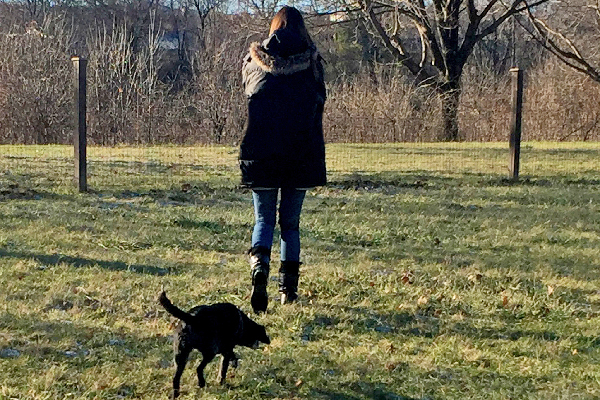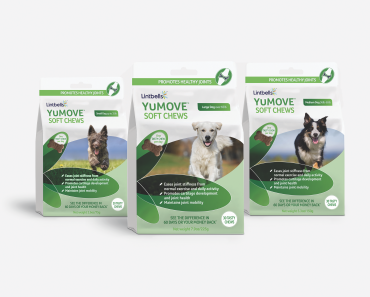If you’ve got an older dog, maybe some of this sounds sadly familiar. You used to go outside and play for hours. At the dog park, those other hounds could never hope to keep up with your quick-footed canine. Your furry friend could easily jump over most obstacles, so putting up pet gates at home was practically futile. But now, things are different. Playtime has dwindled down to a half-hearted romp with a pull toy. Your pup struggles to get in and out of cars. Everything seems to elicit groans of discomfort — from climbing stairs to curling up on the couch. Are these the telltale signs of arthritis in dogs?
Could your dog have arthritis?

What are some common dog arthritis symptoms? Photography ©19msa05 | iStock / Getty Images Plus.
Arthritis isn’t that uncommon among older dogs. Larger breeds may tend to struggle more because of sheer size, but smaller pups certainly aren’t immune. Likewise, the affliction isn’t necessarily exclusive to elderly animals.
“Typical age of onset often depends upon genetics,” notes Dr. Lisa McIntyre, owner and founder of The Welcome Waggin’ mobile veterinary service. “Large breeds are more prone to elbow and hip dysplasia. Small breeds are susceptible to patellar luxation and Legg-Calvé-Perthes disease (LCPD). That first group can actually start showing symptoms at one or two years of age, if they’re afflicted. Though sometimes, we don’t see clinical signs until age seven or older, when joint deterioration and arthritis have begun.”
Regardless of pet life stage, familiarity with common signs of arthritis in dogs can result in faster intervention. That, in turn, can lead to improved quality of life — for everyone involved.
Here are a few signs of arthritis in dogs:
1. Activity Aversion

Activity aversion is one of the signs of arthritis in dogs. Photography by Marybeth Bittel.
Some pet owners might attribute this to simple old age, but it may be one of the signs of arthritis in dogs. According to Dr. McIntyre, general reluctance to walk, exercise, rise and/or recline can be a key symptom of arthritis in dogs. Toys may sit untouched for weeks on end. Stairs may be avoided. Getting up for bathroom breaks might require a nudge, or even a physical hoist.
2. Irritability/Vocalization
Most puppies and younger dogs tend to be pretty happy-go-lucky. But if arthritis starts affecting joints, your trusty companion could get a little testy. Dogs can’t technically “speak up” to tell us they’re in pain, but they can offer plenty of hints. So, dogs with arthritis may groan, grumble, growl — even nip or bite when you try to pet them. They’re communicating physical distress; not a lack of affection for you.
3. Weight Gain/Flabbiness
This was actually the very first arthritis symptom we noticed in my own dog. She’s always struggled with a mild degree of hip dysplasia, and over time she began nibbling and licking at her hip and rear knee area. Our vet pointed out that she’d even begun losing fur directly over the joints. “Some arthritic dogs find this licking self-soothing,” explains Dr. McIntyre, “and the pain draws their attention to the joint in question.” This repetitive behavior might even create skin sores or hot spots.
5. Posture/Mobility Changes

Hunching over is another dog arthritis symptom. Photography by Marybeth Bittel.
As humans, we often tend to favor our own sore knees and ankles. So, it’s probably no surprise that visible lameness is among the signs of arthritis in dogs. Canines with back or neck arthritis may even try to hunch over, hold their head at odd angles, or sit while eating and drinking.
6. Touch Avoidance
Our pups may not understand the source of their pain, but they’ll do anything to avoid it — even pulling away from direct contact with the humans they adore most.
Noticing dog arthritis symptoms? What to do next:

Think your dog has arthritis? Here’s what to do next. Photography ©Smyk_ | iStock / Getty Images Plus.
Remember, all these clues may represent signs of arthritis in dogs — but they could also suggest numerous other issues. So if you notice any type of unusual behavior, always consult your veterinarian. Dr. McIntyre explains that in addition to gently palpating the joints, many vets will perform x-rays, bloodwork and/or urinalysis to screen for tick-borne diseases. “In some cases,” she adds, “advanced imaging such as a CT scan or MRI” may help assist with accurate diagnosis.
If arthritis is indeed the cause, clinical treatment options often include non-steroidal anti-inflammatory drugs (NSAIDs), corticosteroids or a modern systemic medication, such as Adequan. These won’t cure the ailment itself, but they can help control inflammation.
Dr. McIntyre explains that many vets will also try nutraceuticals and/or lifestyle changes as part of therapy. “We know that pain is mediated by several different pathways,” she says, “so a multi-modal approach is the best way to address arthritis.” If your pet is coping with this ailment, here are a few options you may want to consider to ease arthritis symptoms and associated pains:
1. Lifestyle Changes
Think about the kinds of modifications you’d appreciate if you were in chronic discomfort. Dog ramps or steps can help Fido get up on furniture. A lifting harness can provide assistance getting into the car. Orthopedic memory-foam beds can be a dream for aching joints. Food/water bowl platforms can make mealtime less of a (literal) pain in the neck.
2. Acupuncture
This ancient practice is considered one of the five central components of Traditional Chinese Medicine (TCM). It uses baby-fine needles to clear, stimulate, balance and direct energy flow throughout the body. There’s evidence that acupuncture can help reduce inflammation while increasing endorphins, and most pets tolerate it well. Check with the American Academy of Veterinary Acupuncture to find a qualified practitioner near you.
3. Massage/Acupressure
My vet is a huge proponent of regular, gentle massage. It can help stimulate the lymphatic system to eliminate toxins, while soothing muscular tension to ease pain. Never rub the painful joint itself; only around it. Also consider enlisting the services of a qualified acupressure expert, like Tallgrass Animal Acupressure Institute. This is another therapeutic TCM staple that works with energy pathways to help promote general comfort and wellness.
4. Weight Management
Dr. McIntyre feels that this might be the most important measure of all. Even a few pounds can make a world of difference to our hurting canine friends. If increased activity is out of the question, consider reducing treats and discussing a special diet with a pet nutritionist or vet.
5. Hydrotherapy
Swimming strengthens muscles, yet it’s extremely gentle on tender joints. That makes it a totally natural, very effective way to help alleviate dog arthritis symptoms. Search social media for certified canine hydrotherapy facilities, like Chicagoland’s Natural Healing Whole Dog Wellness.
6. Glucosamine and Chondroitin
“I always recommend supplementation with glucosamine-chondroitin products that have been tested for efficacy and quality,” stresses Dr. McIntyre. Indeed, this combination appears to be a fairly well-regarded option for signs of arthritis in dogs. Administering these compounds early can sometimes help to calm inflammation discomfort before joint damage becomes more severe. There are several commercial products containing this blend, with dosages formulated specifically for dogs. Some of these products also contain additional inflammation-reducing compounds, like curcumin.
7. Omega-3
Dr. McIntyre considers this another first-line defense for pet arthritis. Fish oil, like salmon, is packed with omega-3 fatty acids, which can help to quell inflammation. It’s also a natural antioxidant, and doesn’t carry the harsh side effects associated with certain prescription medications. Some products derive omega-3 from green-lipped mussel.
If you’d like to try any of these options, a conversation with your vet is always the smartest approach to determine appropriate dosage. And ultimately, Dr. McIntyre urges pet owners who notice any signs of arthritis in dogs to seek intervention immediately. “Most dogs exhibit pain in understated ways, such as a subtle change in appetite or behavior,” she emphasizes. “So don’t wait for your dog to actually limp or vocalize.” By recognizing the signs of arthritis in dogs and providing caring assistance early, you may delay more pronounced joint damage over time. Best of all, you can help keep your best furry friend more agile, comfortable and content for life.
Check out more natural dog arthritis treatments from Whole Dog Journal >>
Top photograph: SVPhilon | iStock / Getty Images Plus.
Read more about dog health on Dogster.com:


























